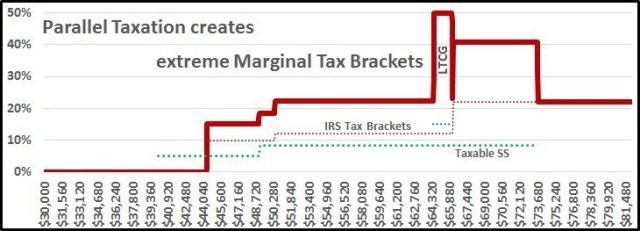Roth IRA Accounts
One of the primary benefits of using a Roth IRA is that you donít pay income tax
when you withdraw funds in retirement. These withdrawals are also not counted as
part of the "basis" for the taxability of your Social Security benefits.
Traditional and Roth IRAs have contribution limits of $5,500 each year. If you are
over 60, that limit is raised to $6,500. If you are single, this limit is phased
out starting at $120,000 and you are ineligible at $135,000. The married filing
jointly and widow(er) filers start the phase out at $189,000 and are ineligible
at $199,000.
There is however a backdoor to making Roth "contributions". You can do a Roth Conversion!
You basically move holdings or cash from your Traditional IRA to your Roth IRA and
pre-pay the taxes as if you had merely withdrawn the funds. There is no Income Cap
on the conversion of Traditional IRA funds to Roth IRA!
The key to the profitability of a Roth Conversion is the marginal tax rate you pay
at the time you make the conversion vs your marginal tax rate when you use the funds.
Letís assume that your Federal Tax Bracket is 22%, your State Tax is 5% and your
Local Tax is 3% for a total marginal rate of 30%. You do a Roth Conversion on $10,000
of your holdings and pay the taxes out of the converted funds. You end up with $7,000
in your Roth account. Many year later, during retirement, all of your retirement
holdings have doubled in value. You now have $14,000 available to spend tax free
in your Roth account. If you did not do the conversion there would be $20,000 in
your Traditional IRA and if your total marginal tax rate was the same 30% you would
have the same $14,000 available after tax! If you moved to a Tax Free State for
retirement, your total taxes due might be only 22% and you would have $15,600. Or,
even if you were in the Tax Free State, but you were also in the 40.7% marginal
tax hump you would only have $11,860 after tax.
P.S. There is also a secondary back door Roth contribution in this previous example.
Instead of paying the taxes out of the converted funds, you can just pay the taxes
from other sources so that the entire $10,000 moves from your Traditional IRA to
you Roth IRA.
|

